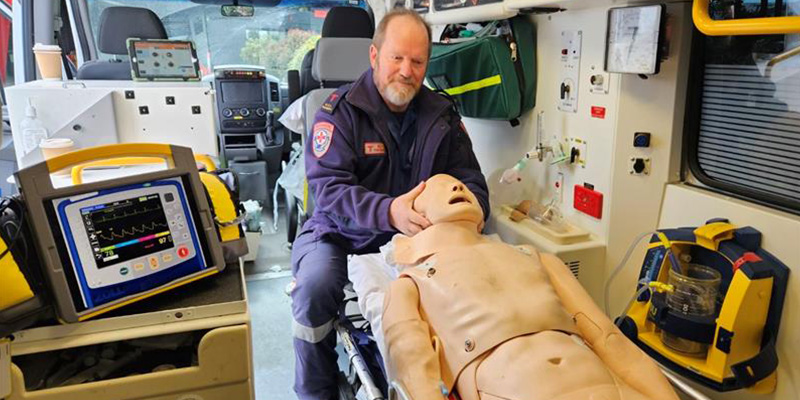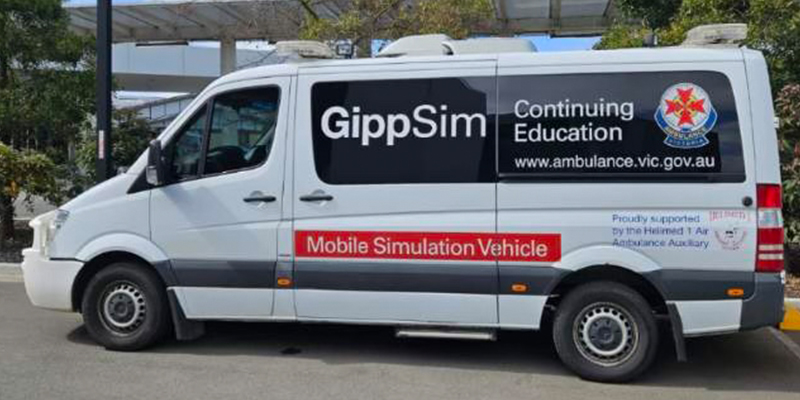A Victorian-first mobile simulation ambulance which helps Ambulance Victoria (AV) paramedics practice high-risk life support skills has helped save a Gippsland man’s life.
The mobile simulation vehicle, known as ‘GippSim’, services Gippsland paramedics by offering them mock scenario sessions while they are in-between patients at hospital.
The innovative truck is the only one of its kind in Victoria offering simulated training for cardiac arrest, seizure, chocking, overdose or asthma attack incidents in a controlled environment, and journeys across regional hospitals three days a week.

AV Clinical Support Officer Mick Azzopardi inside the GippSIM.
In August this year, AV Advanced Life Support (ALS) paramedics Nathan Looby and Kerry Senior undertook airway training in the GippSim at Latrobe Regional Hospital but couldn’t predict that the life-saving skills they’d practiced would be needed for an emergency incident just minutes later.
After their GippSim session, Nathan and Kerry went back on-duty, only to be dispatched 20 minutes later to a 70-year-old man who had collapsed in a Churchill bakery.
Gippsland local, John Sewell, had gone into cardiac arrest and was being treated by quick-thinking bystanders with early cardiopulmonary resuscitation (CPR) and the use of a nearby Automated External Defibrillator (AED).
Kerry said John’s case showed that undertaking scenario-based training in an almost identical environment has real, positive impacts on patient outcomes.
“When Nathan was managing the airway of the patient, he was using the equipment we’d just used in the GippSim 20 minutes ago and I thought to myself, ‘what are the chances?’,” Kerry said.
“Nathan was comfortable and confident in the skills he was performing because he had just trained in using them.
“It highlighted the importance of ensuring paramedics undertake regular skills maintenance training, especially within a life-like environment like the GippSim.”
Nathan said he felt better equipped when responding to John’s case after having just completed a ‘high stress’ training scenario in the GippSim.
“The training actually required advanced airway management and problem solving to resolve life threating complications, which is what we saw in John’s case,” he said.
“This, combined with rapid bystander intervention meant John’s case ran as smoothly as possible.”

John was flown by air ambulance to the Victorian Heart Hospital in a critical condition.
Incredibly, he was discharged five days after his admission and with the insertion of a pacemaker, rehabilitation and medication, he is recovering well.
“All I remember from that day is jumping out of my car and I didn’t feel good,” John recalled.
“To now learn about what happened is amazing. I’d like to thank everyone for helping me that day.”
The GippSim features equipment typically found in an operational ambulance, as well as a simulation patient mannequin, which responds to CPR with its chest able to rise and fall if administered successfully.
The intuitive mannequin can also replicate a trauma patient, be intubated, or have an intravenous cannula (IV) inserted.
AV Clinical Support Officer Mick Azzopardi trained Nathan and Kerry in the GippSim before John’s case and said he was over the moon to hear the training he’d facilitated had been put to the test.
“We provide this opportunity so that paramedics can maintain their skills in a training environment so when they do go out into emergencies, the skills are front of their mind,” Mick said.
Nathan said his experience proved that the GippSim was a great asset to AV’s fleet, and he would utilise the training again in future.
“Training in the GippSim is like training at your own football ground. The environment is familiar, and you are using equipment that is set up like you expect it to be. This allows you to just focus on the skills and the training,” he said.
AV Gippsland Regional Director Ross Salathiel introduced GippSim to the community after it was donated by the Helimed 1 Auxiliary.
GippSIM can be used for a wide range of training scenarios including both ALS and MICA paramedics as well as (ACOs), Non-Emergency Patient Transport (NEPT) training and broader training situations such as mass causality or major incidents.







